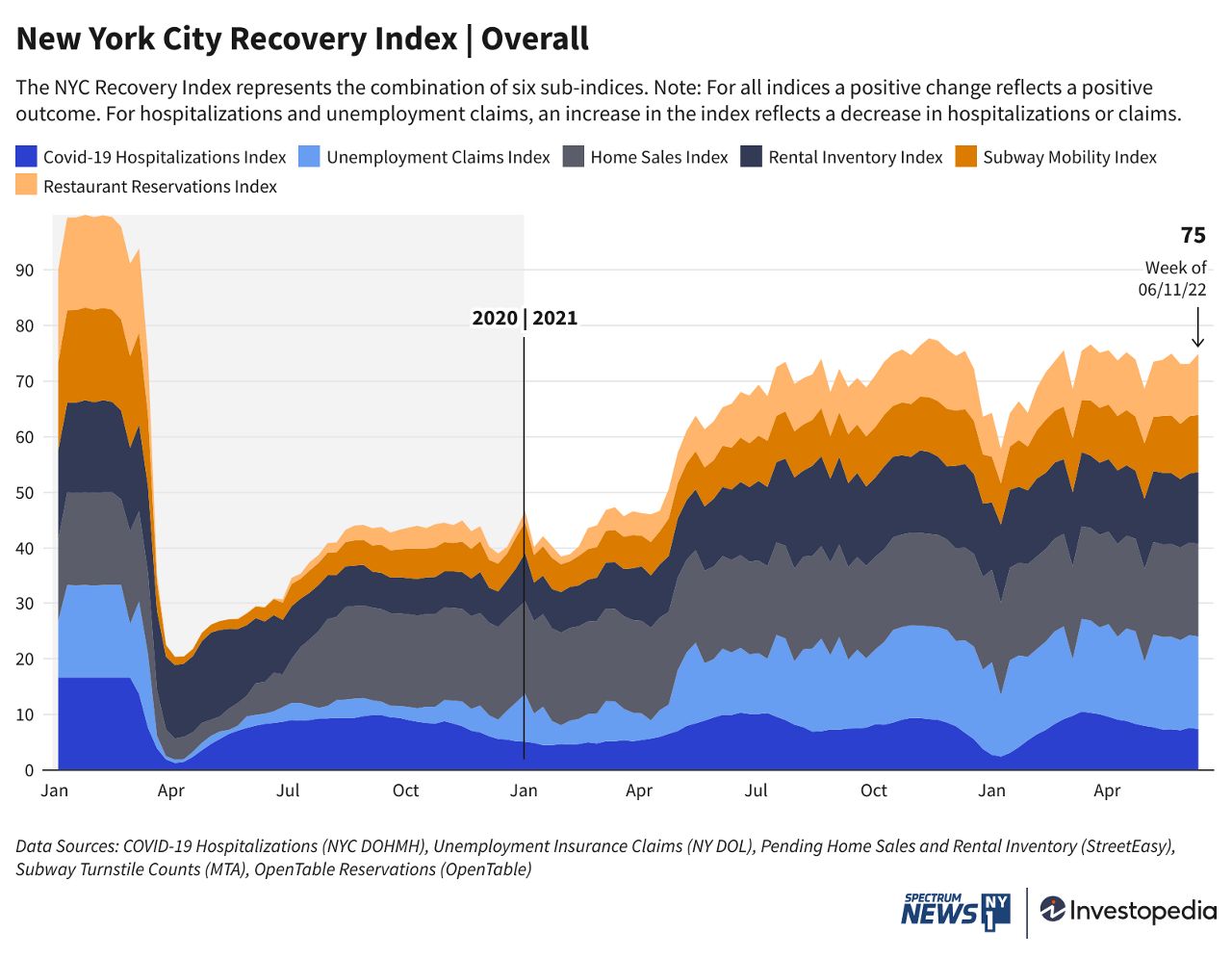New York City’s economic recovery index rose by two points for the week ending June 11, 2022, reaching a score of 75 out of 100. Large increases were recorded in rental vacancies and restaurant reservations, along with a slight increase in home sales. Meanwhile, subway ridership recorded a slight decline, while the COVID-19 hospitalization rate rose.
New York City’s economic recovery stands at a score of 75 out of 100, according to the New York City Recovery Index, a joint project between Investopedia and NY1. Over two years into the pandemic, New York City’s economic recovery is three-quarters of the way back to pre-pandemic levels.
COVID-19 Hospitalizations Back on the Rise
The COVID-19 hospitalization rate in New York City increased during the week ending June 11, as daily hospitalizations rose by 10 to 87.5 on average. The hospitalization rate has been vacillating in recent weeks, from a peak of 98 recorded two weeks ago to a recent low of 77 recorded last week. The current rate remains over five times above the post-omicron low of 18 daily hospitalizations recorded for the week of March 12. The spread of omicron subvariants remains an ongoing public health threat, although hospitalization rates have not increased as rapidly compared to prior waves of COVID-19.
The CDC continues to project that 100% of new cases remain omicron-related. The prevailing BA.2.12.1 strain now accounts for just under 70% of new infections, a slight decline from the 80% share recorded last week. Despite the decline, Region 2 of the Department of Health & Human Services, which encompasses New York, continues to have the highest share of the subvariant among all census regions tracked by the CDC. Meanwhile, the share of fully vaccinated New York City residents continues to inch marginally higher, with 78.8% of residents fully immunized against COVID-19, according to NYC Health & Hospitals data.
Unemployment Claims Rise Slightly
The number of unemployment insurance (UI) claims filed in New York City rose slightly for the week ending June 11. Total claims rose by 440, reaching 5,380. Meanwhile, the 2019 rolling average of claims, tracking the same week of 2019, rose by a comparatively smaller 147 claims, to 5,620. Unemployment claims remain 4% below the pre-pandemic baseline and are therefore still considered fully recovered.
Home Sales Increase
Citywide pending home sales rose for the week ending June 11, recording an increase of 44 sales and reaching a total of 589 weekly sales. Meanwhile, the 2019 total, tracking the equivalent pre-pandemic week, rose by just six homes to 418 in total. With home sales well above pre-pandemic levels, this component of the index remains fully recovered. Breaking down sales by borough, Queens has surged past both Manhattan and Brooklyn, after previously lagging behind its neighbors. Pending home sales in Queens were 55.5% above their pre-pandemic baseline, compared to rates of 37% and 32% in Manhattan and Brooklyn, respectively.
Rental Availability Surges Again
Rental vacancies in New York City recorded another large increase the second consecutive week, surging by 1,128 units compared to a week earlier. As a result, the rental inventory subindex is now over three-quarters of the way to a full recovery, at 77 out of 100 points. Current availability remains about 2,000 units short of the pre-pandemic baseline.
Analyzing the increase in vacancies, Manhattan has recorded the largest rate of increase over the past two weeks, followed by Brooklyn and Queens. The number of rental vacancies in Manhattan rose 9.45% over a two-week period, followed by a 7.7% and 6.4% rate of increase in Brooklyn and Queens, respectively.
On June 21, the New York City Rent Guidelines Board is expected to vote on the city’s next rent increase for rent-stabilized apartments. A preliminary vote last month set a target range for a 2-4% annual rate of increase on one-year leases, with a 4-6% annual rate of increase for two-year leases. Today's vote will come following two years of rents being kept either frozen or increasing minimally due to the COVID-19 pandemic, along with eight years of generally modest increases during the de Blasio administration.
Subway Ridership Declines Slightly
Subway ridership declined slightly for the week ending June 11, with average daily ridership levels falling to 38.5% below the pre-pandemic baseline, from 38% recorded last week. For the week, the Metropolitan Transportation Authority (MTA) reported an average of 2.95 million daily riders. The loss of daily commuters due to remote and hybrid work, relative to the pre-pandemic period, remains a leading cause of depressed ridership. With the start of summer, we can expect more tourists frequenting the subway as peak vacation season arrives.
Restaurant Reservations Rise Decisively
Reservations at New York City restaurants recorded a stunning increase for the week ending June 11, following a large decline over the previous week. Reservations are now 33.8% below the pre-pandemic baseline, compared to 43.7% down last week. This week’s gains nearly fully offset the decline experienced last week, with reservations only slightly below the threshold of 33.1% down recorded two weeks ago. This week’s decisive increase marks the largest week-over-week increase in well over a year, with the trailing seven-day average of reservations up 9.7 percentage points relative to last week.





